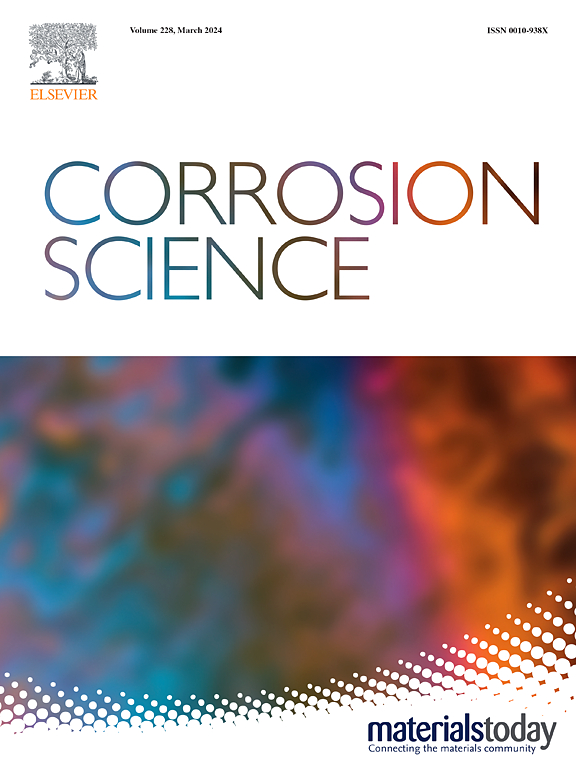通过溶解-扩散-沉积模型深入了解氧气含量对典型模拟土壤溶液中 X70 管线钢腐蚀行为的影响
IF 7.4
1区 材料科学
Q1 MATERIALS SCIENCE, MULTIDISCIPLINARY
引用次数: 0
摘要
本研究采用传统实验方法研究了溶解氧(DO)对低温酸性膨润土模拟土壤溶液中 X70 管线钢腐蚀行为的影响。研究采用了一种新型模型来描述金属/溶液界面上复杂的溶解-扩散-沉积过程。该模型旨在加深对不同氧浓度下 X70 管线钢腐蚀产物层动态以及合金元素(铁、铬和铜)对耐腐蚀性影响的理解。通过将传统实验方法与计算模型相结合,结果发现溶解氧水平与 X70 管线钢的腐蚀速率之间存在正相关。这种关系归因于不同溶解氧条件下形成的腐蚀产物层的不同特征。在低溶解氧条件下,氧化物/氢氧化物的成核和生长速度较慢,从而形成密度更大、保护性更强的腐蚀产物层。相反,在高溶解氧条件下,成核和生长速度加快,氧化物/氢氧化物颗粒变大,从而形成多孔且保护性较差的腐蚀产物层。此外,在不同溶解氧条件下,腐蚀产物层保护质量的变化也会导致腐蚀形态的不同:X70 管线钢在低溶解氧环境下表现出局部腐蚀,而在高溶解氧条件下则表现出更均匀的腐蚀。本文章由计算机程序翻译,如有差异,请以英文原文为准。
Insight into the effect of oxygen content on the corrosion behavior of X70 pipeline steel in a typical simulated soil solution by dissolution-diffusion-deposition model
In this work, traditional experimental methods were employed to investigate the effect of dissolved oxygen (DO) on the corrosion behavior of X70 pipeline steel in a low-temperature acidic-bentonite simulation soil solution. A novel model was utilized to describe the complex dissolution-diffusion-deposition process at the metal/solution interface. This model aims to enhance comprehension of the dynamics of the corrosion product layer of X70 pipeline steel under varying oxygen concentrations, as well as the effects of alloying elements (Fe, Cr and Cu) on the corrosion resistance. By integrating traditional experimental methods with calculation models, the results reveal a positive correlation between DO levels and the corrosion rate X70 pipeline steel. This relationship is attributed to the distinct characteristics of the corrosion product layers formed under different DO conditions. At low DO levels, the nucleation and growth rates of oxide/hydroxide are slower, leading to the formation of a denser, more protective corrosion product layer. Conversely, at high DO levels, the accelerated nucleation and growth rates produce larger oxide/hydroxide particles, resulting in a porous and less protective corrosion product layer. Furthermore, the variation in the protective qualities of the corrosion product layers under different DO conditions causes differences in corrosion morphology: X70 pipeline steel exhibits localized corrosion in low DO environments and more uniform corrosion under high DO conditions.
求助全文
通过发布文献求助,成功后即可免费获取论文全文。
去求助
来源期刊

Corrosion Science
工程技术-材料科学:综合
CiteScore
13.60
自引率
18.10%
发文量
763
审稿时长
46 days
期刊介绍:
Corrosion occurrence and its practical control encompass a vast array of scientific knowledge. Corrosion Science endeavors to serve as the conduit for the exchange of ideas, developments, and research across all facets of this field, encompassing both metallic and non-metallic corrosion. The scope of this international journal is broad and inclusive. Published papers span from highly theoretical inquiries to essentially practical applications, covering diverse areas such as high-temperature oxidation, passivity, anodic oxidation, biochemical corrosion, stress corrosion cracking, and corrosion control mechanisms and methodologies.
This journal publishes original papers and critical reviews across the spectrum of pure and applied corrosion, material degradation, and surface science and engineering. It serves as a crucial link connecting metallurgists, materials scientists, and researchers investigating corrosion and degradation phenomena. Join us in advancing knowledge and understanding in the vital field of corrosion science.
 求助内容:
求助内容: 应助结果提醒方式:
应助结果提醒方式:


